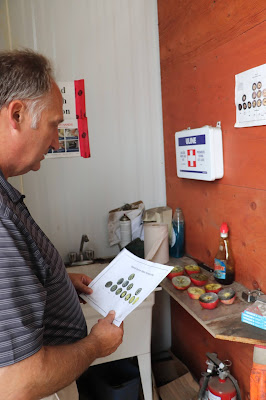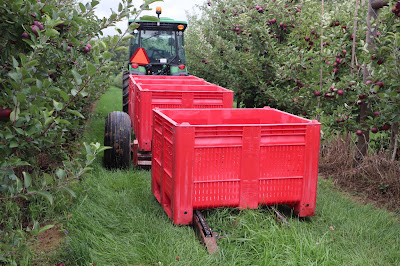In my Orchard Days blog series so far, I've done posts on the planting, maintenance, blossoming, pruning, and thinning aspects of raising apples. Now we come to the fifth and final installment in the series - picking the apples. Marking the end of a growing season, harvesting has to be one of the most rewarding aspects for the fruit farmer and his crews.
Fruitful boughs in readiness for harvest.
One of the jobs required in preparation for apple-picking is the washing of storage bins. Picked apples are placed into either wooden or plastic 20-bushel crates. These bins need to be cleaned of last year's dirt and debris so that this year's apples have a tidy place in which to be stored. The workers in the pics above were busy pressure-washing the bins. One fellow, though, wasn't too busy to wave when he saw me taking the picture.
One day when I went with Ken to the Vienna orchards, he demonstrated some of the tests he gives apples during the harvest season. Here he is using a measuring gadget to test sizing of the apples. This tool can help him answer this type of question, "Are the Red Delicious in this block ready (big enough) to pick this week?"
Another test is to determine starch levels in apples. A growing apple has more starch than sugar in it. As the fruit matures, it gets sweeter. This ripening is indicated by a decrease in starch as the sugar level increases. The level of starch in the apples can help in determining the optimum time for picking a particular variety.
Ken collected some samples of a few apple varieties as he drove through the orchard. He brought those apples to his testing station in one corner of the storage building, and cut the fruit in half lengthwise. He sprayed an iodine solution onto the cut surface of the apples. The iodine reacted with the starch and created a blue-black stained pattern after a minute or two.
Ken compared the results with a chart for that particular apple variety, using it as a guide to determine if the apples were immature, mature, or over-mature. The apples showing the darkest patterns indicated there was still plenty of starch in those; they were not yet at optimum ripeness for picking.
Yet another method to check for apple harvesting readiness is measuring the brix or, in other words, testing the sugar levels. For this test, Ken quartered the apples and squeezed a section of apple until enough juice dripped out to collect on the brix measuring device called a refractometer.
This portable digital brix measurer is handy and gives quick results. Brix readings less than 11 (12 for Honey Crisp) are considered low; higher than 13 (14 for Honey Crisp) are excellent. In any case, the apple that was tested in this photo indicated its variety was not yet ready for picking, since it showed a 10.7 on the screen.
Other essential equipment for picking includes ladders and buckets. An orchard ladder's distinguishing feature is its single "back leg" for easier maneuvering among trees. The picking bucket has a bag extension to help guard against bruising of the apples when they are put into bins. Short sections of rope at the bottom end of the bag are placed into hooks at the sides of the bucket's top rim to keep the bag up and out of the way as the bucket is being loaded with apples during picking.
Bins are brought to the orchard rows on a bin hauler pulled by a tractor. The bin hauler loads and unloads the bins by use of a hydraulic pick up chain.
When an apple picker has his bucket full, he comes to the bin, unhooks the bag extension and empties the bucket out the bottom by gently releasing the apples through the bag and onto the mound already in the bin.
Here Ken is on the job coaching his workers. They call him The Boss, Bossy (more because they like to put an "ee" sound on the end of their words, than that they think it describes his demeanor), and The Chief. (The latter term is my favorite. One time recently I even got referred to as The First Lady by one of the workers, because of my association to The Chief.)
The two pictures above show what kind of damage hail can do to apples. Thankfully, our orchards got very little hail this year, and the overall crop did not suffer hail damage in any significant way.
Rather, the bins were filled with bucketful after bucketful of phenomenal fruit. (Thanks be to God!)
I felt so privileged to be able to tag along with Ken on the job a few times during harvest. This pic shows the glorious weather we had on one of those days.
I enjoyed making the rounds in the orchards with Ken on the four-wheeler. (When I showed this picture to my family, one of my brothers commented that our province must require us wearing some serious Covid masks!)
Apples in the cupholder - a typical sight in my man's vehicle during harvest.
Photo credits for these two bounty pics go to The Chief.
The tractor-trailers at Martin's are another part of essential harvest equipment. They will continue to be used often in the months to come, long past harvest. They are important in the process of getting fresh apples from our orchards to grocery stores, and hopefully that's to a store near you!
Here is a final pic in this Orchard Days series: my favorite farmer among his favorite fruit.


































No comments:
Post a Comment